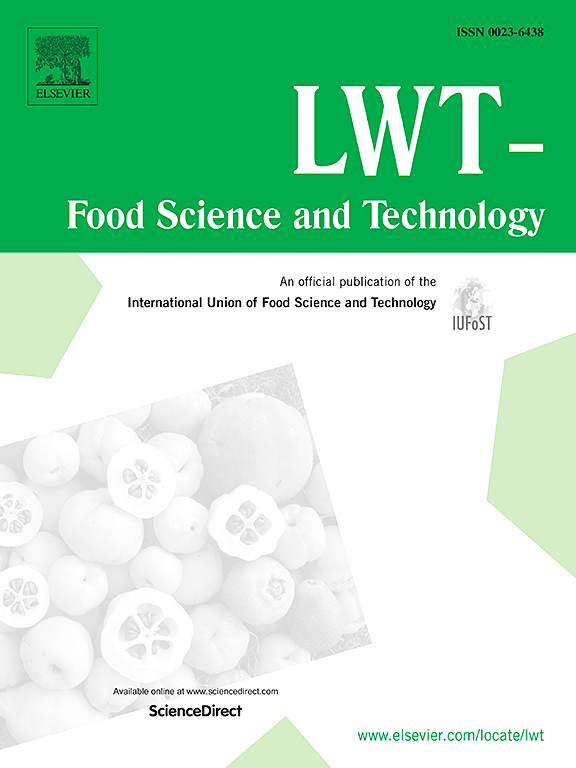Effects of Pediococcus acidilactici and Rhizopus Oryzae on protein degradation and flavor formation in fermented mutton sausages
IF 6
1区 农林科学
Q1 FOOD SCIENCE & TECHNOLOGY
引用次数: 0
Abstract
Protein degradation occurs during the fermenting of traditional mutton sausages, which influences on the flavor and quality of products. In this study, HS-SPME-GC-MS and Sodium dodecyl sulfate-polyacrylamide gel electrophoresis were used to study the degradation kinetics of myofibrillar protein (MP) and sarcoplasmic protein (SP) during fermentation and ripening of fermented sausages by single and mixed starters (Pediococcus acidilactici CICC 10344 and Rhizopus Oryzae ATCC 96382). It was shown that flavor formation and protein degradation are related. Adding mixed starters effectively reduced the loss of sulfhydryl content compared to single starter. Moreover, cathepsin B and cathepsin L activities were continuously enhanced during sausage fermentation. Analysis of SDS-PAGE showed processing affected protein degradation, and the degree of degradation was increased with increasing fermentation time. Meanwhile, the inoculation of mature sausage samples with mixed starters accelerated the production of water-soluble flavor compounds (e.g., free amino acids and TCA-soluble peptides). The mixed starters group had more amino acids presenting the umami-free amino acids. Based on the ROAV values for odor thresholds, we identified 12 key volatile flavor compounds. The correlation heat map showed higher concentrations of key volatile flavor compounds in the mixed starters. Overall, Pediococcus acidilactici and Rhizopus Oryzae addition may effectively improve the flavor quality of fermented sausage products during fermentation.
酸乳球菌和根瘤菌对发酵羊肉香肠中蛋白质降解和风味形成的影响
蛋白质在传统羊肉香肠的发酵过程中会发生降解,从而影响产品的风味和质量。本研究采用 HS-SPME-GC-MS 和十二烷基硫酸钠-聚丙烯酰胺凝胶电泳法研究了单一和混合发酵剂(Pediococcus acidilactici CICC 10344 和 Rhizopus Oryzae ATCC 96382)在发酵香肠的发酵和成熟过程中肌纤维蛋白(MP)和肌浆蛋白(SP)的降解动力学。研究表明,风味的形成与蛋白质的降解有关。与单一发酵剂相比,添加混合发酵剂可有效减少巯基含量的损失。此外,在香肠发酵过程中,酪蛋白酶 B 和酪蛋白酶 L 的活性持续增强。SDS-PAGE 分析表明,加工过程会影响蛋白质的降解,而且降解程度会随着发酵时间的延长而增加。同时,用混合发酵剂接种成熟香肠样品可加速水溶性风味化合物(如游离氨基酸和 TCA 可溶性肽)的产生。混合发酵剂组有更多的氨基酸呈现出不含鲜味的氨基酸。根据气味阈值的 ROAV 值,我们确定了 12 种主要的挥发性风味化合物。相关热图显示,混合开胃菜中主要挥发性风味化合物的浓度更高。总之,在发酵过程中添加酸乳球菌和根瘤菌可有效改善发酵香肠产品的风味质量。
本文章由计算机程序翻译,如有差异,请以英文原文为准。
求助全文
约1分钟内获得全文
求助全文
来源期刊

LWT - Food Science and Technology
工程技术-食品科技
CiteScore
11.80
自引率
6.70%
发文量
1724
审稿时长
65 days
期刊介绍:
LWT - Food Science and Technology is an international journal that publishes innovative papers in the fields of food chemistry, biochemistry, microbiology, technology and nutrition. The work described should be innovative either in the approach or in the methods used. The significance of the results either for the science community or for the food industry must also be specified. Contributions written in English are welcomed in the form of review articles, short reviews, research papers, and research notes. Papers featuring animal trials and cell cultures are outside the scope of the journal and will not be considered for publication.
 求助内容:
求助内容: 应助结果提醒方式:
应助结果提醒方式:


